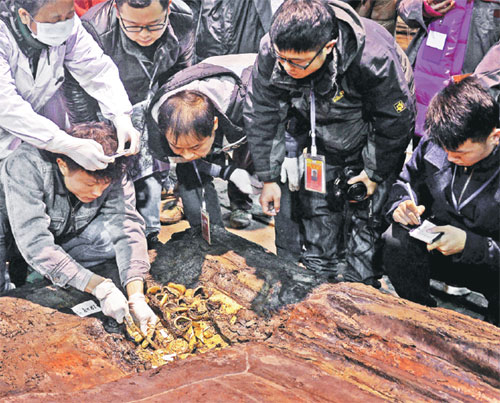Gold plates indicate tomb's royal Han origin
Archaeologists believe site is the grave of emperor deposed after 27 days on throne
Ongoing archaeological exploration at a high-profile Western Han Dynasty (206 BC-AD24) tomb site in eastern China has yielded new finds some bearing typical traits that experts say belong to Han royal family.
Gold plates, rarely seen in other contemporary Han archaeological finds, were discovered and removed for the first time since the Marquis Haihun tomb excavation started in 2011. About 10 gold plates were carefully sorted out and placed on clean cloths.
The new finds, together with excavated hoof-shaped gold ingots inlaid with jade or glass - a material typically used solely by the royal Han family-are seen as new proof that the tomb belonged to Liu He (92-59 BC), the deposed eighth Han emperor who reined for only 27 days, according to Yang Jun, the excavation team leader.
"This (finding of the gold plates) give us more reasons to believe the tomb belongs to a high-ranking royal Han family, and to be more specific, Marquis Haihun", Yang said at the site of the tomb chamber.
As for when the archaeologists will open the inner coffin, he said that due to changing excavation conditions, expert team members are still evaluating the outer and inner condition of the coffin and a final decision has not been reached.
Marking one of the most important archaeological discoveries in decades, the excavation has become a buzzword in the Chinese community. Journalists from all forms of Chinese media have flocked to the excavation site and research lab in the suburbs about a 90-minute drive from Nanchang.
"The gold plates served as gold reserve of the ruling marquis," said Xin Lixiang, the head of the excavation's expert panel.
Liu He was dethroned due to what Book of Han described as his inappropriate debauchery and licentious way of life, making him the shortest reining Western Han emperor.
He was given the Haihun marquis title and relocated to present-day Nanchang, Jiangxi province.
About 100 gold discs and gold hoof-shaped ingots were excavated from the tomb on Thursday. The ancient Chinese character zhong (middle) was inscribed on some of the ingots, the significance of which is not yet known.
In addition to the gold plates unearthed on Friday, 78 kilograms of golden artifacts has been excavated. Based on Friday's gold price-223 yuan ($34.5) per gram - the treasure is worth $2.7 million, not counting its historical and archaeological value.
leixiaoxun@chinadaily.com.cn
|
Archaeologists are working with some of the 285 golden ingots found at the Marquis Haihun tomb excavation site on Thursday in Nanchang, capital of Jiangxi province. Wan Xiang / Xinhua |



















